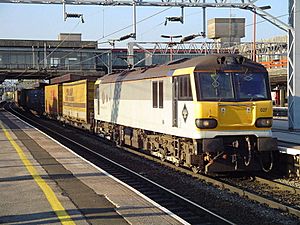British Rail Class 92 facts for kids
Quick facts for kids British Rail Class 92 |
|
 |
|
| 92027 George Eliot at Stafford in August 2005 with an intermodal train | |
| Power type | Electric |
|---|---|
| Builder | Asea Brown Boveri and Brush Traction |
| Build date | 1993–1996 |
| Total production | 46 (seven stored) |
| Configuration | Co-Co |
| UIC classification | Co'Co' |
| Gauge | 1,435 mm (4 ft 8 1⁄2 in) |
| Length | 21.34 m (70 ft 0 in) |
| Width | 2.64 m (8 ft 8 in) |
| Height | 3.95 m (13 ft 0 in) with pantograph down |
| Locomotive weight | 126 tonnes (124 long tons; 139 short tons) |
| Electric system(s) | 25 kV AC and 750 V DC |
| Current collection method | 25 kV: Pantograph, 750 V: Third rail |
| Traction motors | ABB traction converters using GTO, control via ABB MICAS-S2 |
| Top speed | 87 mph (140 km/h) |
| Power output | 25 kV: 6,760 hp (5.04 MW), 750 V: 5,360 hp (4.00 MW) |
| Tractive effort | 360 kN (81,000 lbf), 400 kN (90,000 lbf) with 'boost' mode applied |
| Locomotive brakes | Westinghouse air, rheostatic and regenerative |
| Train brakes | Westinghouse air |
| Career | EWS Eurotunnel/Europorte 2 SNCF |
| Number | 92001–92046 |
The Class 92 is a special type of electric train engine, also known as a locomotive. It was built in Britain and can use two different types of electricity to run. This makes it very flexible! It was designed especially to pull trains through the Channel Tunnel, which connects Britain and France. The company that runs the Channel Tunnel, Eurotunnel, even uses the Class 92 as an example for other trains that want to use the tunnel.
Contents
What Makes Class 92 Trains Special?
These locomotives are called "dual-voltage" because they can get their power from two different sources.
- One way is from overhead lines, which carry 25,000 volts of alternating current (AC). This is like the electricity that powers many homes.
- The other way is from a special rail on the ground, called a "third rail," which carries 750 volts of direct current (DC). This is a different type of electricity.
This ability to switch power sources means the Class 92 can travel on different railway systems without needing to change engines. This is super helpful for international journeys like those through the Channel Tunnel.
Designed for the Channel Tunnel
The main reason the Class 92 was built was to work in the Channel Tunnel. The tunnel has its own special rules and power systems. These trains are strong enough to pull heavy freight trains and even passenger trains through the long tunnel. Their design helps make sure trains can move smoothly between Britain and France.
How Many Were Built?
A total of 46 Class 92 locomotives were made between 1993 and 1996. They were built by two companies: Asea Brown Boveri and Brush Traction. Many of them are still in use today, pulling important cargo across the country and through the tunnel.
Images for kids
-
Repainted 92009 in DB Schenker red livery at Dollands Moor, during trials over High Speed 1.
-
Midnight Teal liveried 92033 at Crewe, having been moved from Brush Traction to Crewe for testing.




